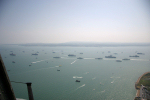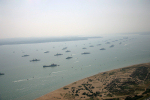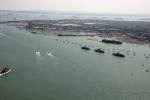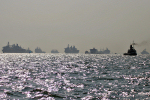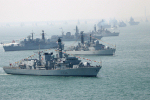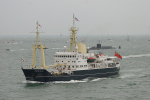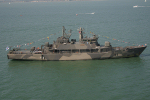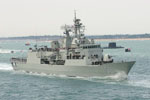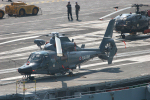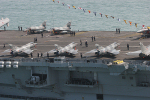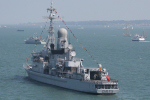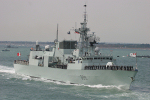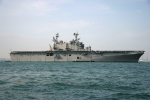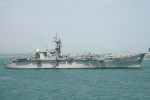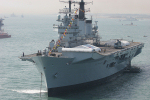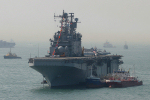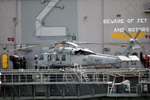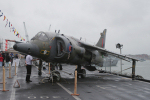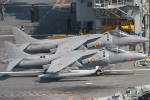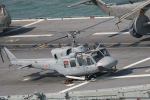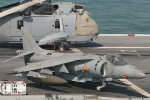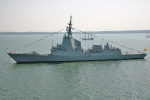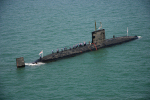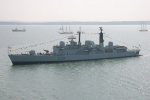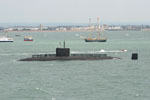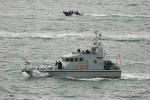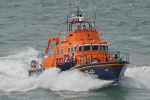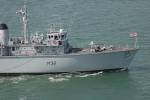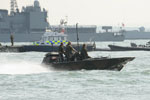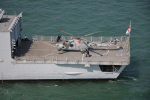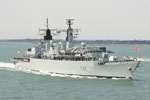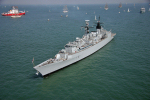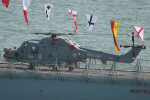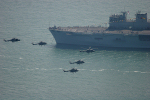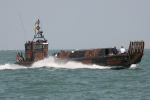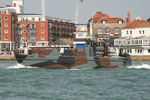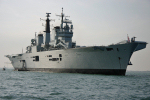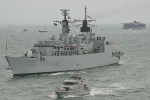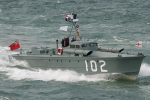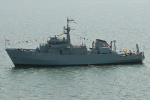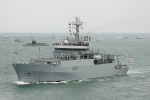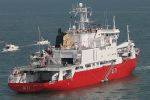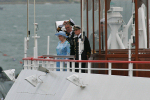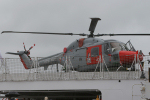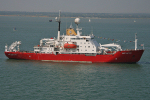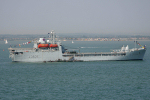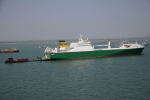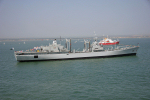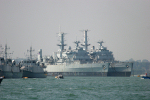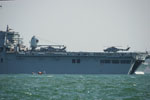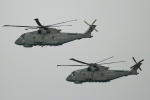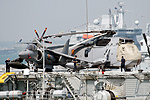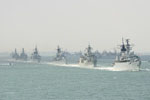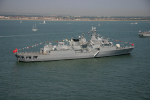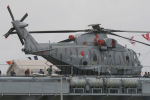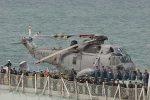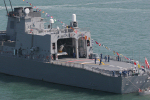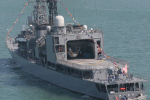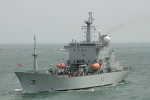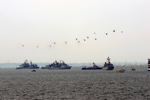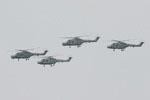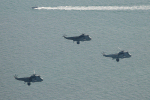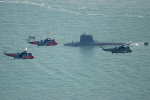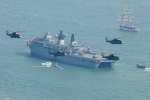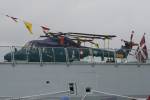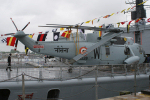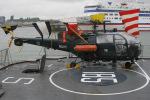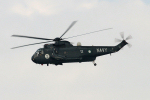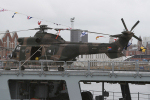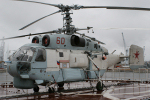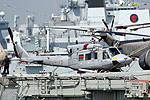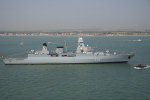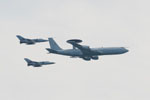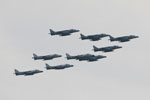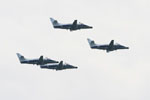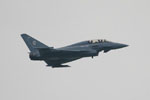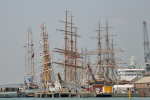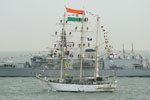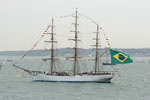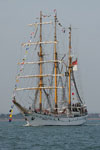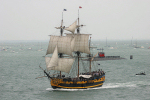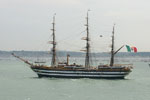To
celebrate the bicentenary of this battle, possibly the most famous naval
battle ever fought, the Royal Navy staged the "Trafalgar 200"
celebrations in late June off the coast of Portsmouth and Gosport in
the sheltered waters of The Solent. The Battle of Trafalgar was actually
fought in October but we'll not split hairs as we all known what the
British weather in October could be like. The Queen was on hand to review
the fleet and witness the impressive massing of 112 ships, the largest
since the 1977 review, from nations ranging from Algeria to the United
States and Australia to Uruguay and of vastly differing sizes and capabilities
- the combined firepower of these 112 ships is simply mind-boggling.
On the one hand, there are the unarmed vessels and on the other hand,
right at the other end of the spectrum, are the cruise missile armed
vessels and aircraft carriers with potentially nuclear armed aircraft
in the airwing. Flypasts and displays of both our own air assets and
those from attending nations were also part of the impressive itinerary
for the International Fleet Review. The celebrations also sadly marked
the very last time a Royal Navy Sea Harrier would take place in any
form of a fleet review as all Sea Harriers have now been withdrawn from
service to be replaced in the carrier-borne strike role by the Harrier
of “Joint Force Harrier” which are planned to be eventually
replaced by the Joint Strike Fighter in about six years time. |
|
|
Standing
head and shoulders, well, flightdeck and island anyway, above anything
else and looking every inch a modern warship, was the nuclear-powered
R91 P.A. (Porte-Avions) Charles de Gaulle. The de Gaulle is the spearhead
of French surface naval power and gives to the French what a Nimitz-class
carrier gives to the USN – power projection on a scale that simply
deploying aircraft to a regional airfield cannot do. OK, so the 40,000t
de Gaulle is less than half the size of a Nimitz-class “supercarrier”
but as far as a rogue state (or anyone else doing things that perhaps
they shouldn’t) goes, the aircraft aboard are more than capable
of performing pretty much any role asked of them. Even though it's half
the size of the most impressive ships to roam the high seas, at 40,000t
it’s still twice the displacement of HMS Ocean and the Invincible-class
STOVL carriers. Deploy thirty jets to a friendly base in a country nearby
and the nation under pressure might not even bat an eyelid - park a
carrier off the coast and you'll probably have their complete and undivided
attention. The arrival of any aircraft carrier, particularly those of
large dimensions, off the coast of an “unfriendly” nation
means only one thing – the country named in the owner box on the
warranty card means business and it takes the saying "expect a
gunboat at dawn" to a whole new level. To say aircraft carriers
can have more aircraft embarked than some nations have in their entire
military is not an over-exaggeration. |
Dropping anchor off Spithead on the weekend before the celebrations began, the de Gaulle had a reduced air wing embarked – four F1-standard Rafale Ms of 12F from Landivisiau, six Super Etendard Ms of 11F also from Landivisiau and two E-2C Hawkeyes of 4F from Lorient plus a single Dauphin and Alouette III helicopter. All of which were hangared below-deck for their arrival and were brought topside a little later bringing some degree of life to the four acre flightdeck. The remainder of her air wing, about 26 aircraft, had left for their home bases prior to the arrival in the Solent. Wherever a carrier goes, a strike group goes with it and these strike groups invariably contain at least one hunter-killer submarine as arguably the best way of finding a submarine is with another submarine that doesn’t necessarily have to sail in relatively close proximity to the carrier like the destroyers and cruisers do. The de Gaulle was no different – accompanying her in the Solent were two surface combatants in the shape of the destroyer FS Tourville and the AS.565MA Panther-equipped air-defence frigate FS Jean Bart in addition to the FS Meuse replenishment ship plus the S606 FS Perle, the sixth and last boat of the Rubis-class hunter-killers. Obviously the strike group wasn’t “combat ready” in terms of being able to mount and sustain combat operations but no-one in their right mind would let more than three billion Euros worth of warship roam the oceans with no support or backup. Allowing a submarine to do its job, all alone, is one thing, letting something as obvious and visible as a carrier do the same think is tantamount to sheer craziness. |
|
|
Nothing
could highlight the shift in modern seapower more visibly than the line-up
of carriers. Less than 200 years ago, the Royal Ensign undoubtedly ruled
the waves. Now, a US Navy amphibious assault ship is almost twice as
large as HMS Ocean - the largest ship in the Royal Navy and tasked with
a role almost identical to that of the said US Navy amphibs! Beyond
any shadow of any doubt, it is quite obvious what the dominant seapower
is now... and it flies the Stars and Stripes on its ships. The Tarawa-class
LHA-2 USS Saipan is roughly the same size the largest warship in Europe
(the de Gaulle), yet in the grander scheme of all things USN it is still
a "baby". When you consider that it is simply a mobile Marine
base that can literally go anywhere, anytime, the Saipan and her counterparts
are quite an achievement – this mobile base can pack a massive
punch too. When embarked with the full compliment of six AV-8B Harrier
II/II+s, twelve CH-46 Sea Knights, nine CH-53E Sea Stallions, four AH-1W
Super Cobras and four UH-1N Iroquis helicopters plus roughly 2,000 combat
ready, armed-to-the-teeth, Marines, an LHA or the slightly larger LHD
can seriously ruin someone’s day. The LHA/LHD of the future will,
however, look slightly different – the CH-46s will be replaced
by the MV-22B Osprey tilt-rotor and the CH-53Es will be replaced, under
the HLR Programme, by the larger CH-53K Super Stallion in about 8 years
time. Furthermore, the AH-1Ws and UH-1Ns will eventually be replaced
by 180 AH-1Z Vipers and 100 UH-1Y Venoms – the main advantage
of the new versions being that they offer an 84% parts commonality,
somewhat more than the AH-1W and UH-1N had in common. Since late 2000,
the H-1s involved in the development process have amassed more than
3,300 flight hours from 3,000 sorties during which they have fired more
than 2,000 unguided 70mm rockets, 13,500 rounds of ammunition, eleven
AGM-114K Hellfire IIs and three AIM-9 Sidewinders. About 1% of those
flight hours (with a total of 267 landings) were undertaken on or about
the LHD-5 USS Bataan to test their ability to operate in the shipborne
environment. |
The
Saipan was deployed in support of the fleet exercise "GWOT Surge
05" and took part in Adriatic Engagement 05 with the Albanian and
Macedonian armed forces yet the only embarked aircraft were two MH-60S
Knighthawks of HSC-26/Det 2 Chargers and a lone CH-46D Sea Knight in
HC-8 Dragon Whales markings. HC-8 technically doesn’t actually
exist as they were re-designated as HSC-28 in early 2005 due to the
creation of the “Helicopter Sea Combat” squadrons thanks
to the merger of the anti-submarine and combat support communities.
The introduction of the MH-60S Knighthawk and the future introduction
of the MH-60R Seahawk is basically the reasoning behind the “multirole”
HSC units as multi-mission MH-60R/Ss will basically replace all current
USN helicopters from the SH-60B Seahawk right up to the massive MH-53E
Sea Dragon and will also replace the SH-60Fs/HH-60Hs on a carrier deck.
The plan was for the aircraft carrier USS Carl Vinson to have attended
on its way to its new NS Norfolk home but an extended operational period
with 5th Fleet somewhere in the Middle East region soon put paid to
that idea and the personnel of the USS Saipan were only aware of their
participation just a short while beforehand. Nearly all the personnel
we spoke to on the Vinson whilst in the Med were all looking forward
to taking part in the celebrations – but it just was not to be.
A Nimitz-class carrier in the already impressive line-up would have
been quite an addition and certainly put a whole different spin on things
as it quite simply would have dwarfed its neighbours. |
|
|
Almost
proving that past histories, and the altercations therein, between the
naval powers of the UK, France and Spain had been put firmly to bed
was, in addition to the French presence, the attendance of the Spanish
flagship – their own aircraft carrier, the SNS Principe de Asturias.
Based on the USN’s “Sea Control Ship” design of the
1970s but subjected to a few changes to improve habitation and VSTOL
aircraft support, the 17,000t Principe de Asturias is similar to the
Invincible-class carriers in that she is of a similar size and has a
ski-ramp; the ski-ramp is, at 12º, a little steeper than the 7º
ramp of the Invincible-class carriers though the normal air wing is
also strikingly similar to her counterparts in the RN i.e. Harriers
and helicopters. Although the ability is there to support nearly thirty
aircraft, a typical airwing comprises twelve EAV-8B Harrier IIs, six
SH-3H Sea Kings, four AB.212ASWs and two SH-3H AEW Sea Kings –
all of which are home based at Rota in south-western Spain and not that
far from where the Battle of Trafalgar was fought. Accompanying the
de Asturias into UK waters was SNS Blas de Lezo – from the same
class of destroyers that went on to make history in September when SNS
Alvaro de Bazan was deployed to the Middle East region attached to the
USS Theodore Roosevelt’s Carrier Strike Group Two and operated
under USN 2nd, 5th & 6th Fleet commands. Incidentally, the Alvaro
de Bazan-class multipurpose frigates are the first ships in Europe to
be equipped with the US AEGIS missile system (including the Mach 2.5
RIM-66M-2 SM-2 Block IIIA Standard MR surface-to-air missile) which
makes the Spanish ships roughly comparable to the USN’s Arleigh
Burke-class (thus also Japan’s Kongo-class) guided missile destroyers
and are the basis for the new Norwegian Fridtjof Nansen-class, also
AEGIS-equipped. |
Obviously
the "Home Team" of the Royal Navy couldn’t let all these
foreign navies have it all their own way when it came to impressing
the amassed crowd of almost 250,000. Although they couldn’t field
a size advantage, they could field a number advantage and as most know,
a number advantage is a good thing (except for Villeneuve when Nelson
is the OC of the outnumbered force). In amongst the forty-seven RN vessels
was everything from small harbour-patrol-like craft up to the Tomahawk-armed
HMS Trafalgar, HMS Trenchant and HMS Turbulent of the Second Submarine
Squadron down at Devonport – the record setting ‘T-Boat’
nuclear-powered hunter/killer submarine is said to be one of the finest
and most fearsome SSN types roaming the oceans and is armed with the
90mph+ Spearfish torpedo plus the aforementioned Tomahawk cruise missile.
Sadly I didn’t see a Vanguard-class ‘V-Boat’ ballistic
missile submarine but considering its Yangtze River Dolphin-like elusiveness
that was hardly surprising. Armed with up to sixteen UGM-133A Trident
II D-5 ballistic missiles each with multiple independently targeted
re-entry vehicles with a yield of up to 120kT each, the four Faslane-based
Vanguard boats are currently the UK’s sole nuclear deterrent after
the RAF lost the last of their free-fall unguided WE.177s in 1998. |
|
|
Perhaps
the smallest RN warships on the guest list (bar the small high-speed
boats providing a security curtain to the attending vessels) were the
Archer-class patrol boats – also known as P2000s. If you were
to think of a miniature version of a large RNLI lifeboat, albeit one
that wears an overall grey scheme, you’d not be far from picturing
what a P2000 looks like. Even though they are “patrol” boats,
they are used for training and are typically unarmed unless in times
of crisis when machine guns can be swiftly added. Even though they tip
the displacement scales at just 40t and have a complement that numbers
just ten, the P2000s appear to be quicker than their stated maximum
speed of about 25 knots. The mine countermeasures community, which has
a role perhaps more important than any other vessel when it comes to
ensuring shipping lanes can be used, was represented at the review by
the almost entirely non-magnetic Sandown-class minehunters and the larger
Hunt-class minesweepers. In 1990-1991, five Hunt-class vessels (M30,
M31, M35, M38 & M39) sailed with the two US battleships of USS Missouri
and USS Wisconsin to provide a much needed mine escort capability to
two of the greatest ever symbols of seapower - ask anyone about warships
and they'll undoubtedly mention "battleship". In much the
same way that the public know what an F-14 looks like thanks to Top
Gun, most also know of the battleship. Additionally, Hunt-class minesweepers
also have a secondary role of patrol and fisheries protection. You may
say “well, a minehunter is a minesweeper” – that’s
not quite true. Minehunters use sonar to hunt down and destroy individual
mines whereas a minesweeper will attempt to clear an area without prior
detection of the mine(s). So whilst both result in passable waterways,
their method of achieving that goal is somewhat different. |
Representing the Broadsword-class Type 22 Batch 3 frigates, basically refined examples of the Batch 2 types that saw action in the Falkands, were HMS Cambeltown, HMS Chatham (the 'star' of the TV show Shipmates) and HMS Cumberland. Batch 3 refinements over the older Batch 2 types include a slight length and displacement increase, different powerplants, fewer personnel and a change to the armament. The Exocet MM.38 capability of the Batch 1 and 2 ships has been removed in favour of the RGM-84D Harpoon and the flightdeck is now capable of supporting Sea King and Merlin operations rather than just the Lynx. The mainstay of the Royal Navy, the ultra-quiet "stealthy" Type 23 Duke-class frigate, was adequately shown off by the fact that there were no less than seven such ships in attendance. Yes, seven. Two Type 23s, HMS Grafton and HMS Somerset, were involved with operations during the Kosovo campaign as they were attached to the R99 P.A. Foch carrier strike group between late March and the end of May with Grafton relieving Somerset after the first month. As if the similarity between the Type 22s and Type 23s wasn't bad enough, the Type 42s in the line-up just made things just that tad more complex for the casual observer. Five of these things added to the tally although four were Sheffield-class Batch 2s (which meant all of the Batch 2s were at the review) and one was HMS Manchester, one of the longer Batch 3 ships. Whilst the foray into the South Atlantic in 1982 wasn't particularly successful for the Type 42s (HMS Sheffield and HMS Coventry were both sunk), they proved more successful in 1990-1991 in the Persian Gulf and with just moments to spare, HMS Gloucester engaged and destroyed an Iraqi Silkworm missile heading toward USS Missouri. All Type 42s will eventually be replaced, as will the Sea Harrier F/A.2s, by the most advanced warship ever designed - the PAAMS-equipped Type 45 Area Air Defence Destroyer. With the Aster-15 and Aster-30 missiles offering a range of 30km and 80km respectively and a firing rate of eight missiles in just ten seconds, it's fair to assume that a strike group is well protected... but a Sea Harrier it ain't! Most of the Type 22, Type 23 and Type 42 ships had a Lynx embarked (just four out of the fifteen hadn’t) and were predominantly of the latest HMA.8 “Super Lynx” type with the chin mounted Seaspray 3000 radar and nose-mounted Sea Owl electro-optical device, the rest being HAS.3s with the exception of HMS Westminster which was equipped with an 829NAS Merlin HM.1. An 824NAS Merlin HM.1s could be also seen lurking on HMS Invincible (alongside a P.1127, Harrier GR.3 and 849NAS Sea King ASaC.7) with an 814NAS example being embarked aboard RFA Fort Victoria. When it comes to the Lynx and irrespective of the type, all were operated by 815NAS from RNAS Yeovilton with the exception of the 702NAS HAS.3 on HMS Grafton. |
|
|
The
Royal Navy's largest ship, L12 HMS Ocean, the lead and only ship of
the amphibious assault Ocean-class was also in attendance and anchored
in the “carrier line-up”. A Landing Platform Helicopter
(LPH) she may be, but she is based on the design of the Invincible-class
albeit with a redesigned island and new propulsion systems although
she lacks the bow ski-ramp. Ocean became the ship upon which “seaborne”
Apache AH.1s were trialled – the first ever time any Apaches had
been tested at sea... and yes, that includes the United States. For
about three months in early 2004, Apache AH.1s conducted more than 700
take-off and landings from HMS Ocean's flightdeck in varying sea states.
Following this trial, it is expected that the Commando Helicopter Force
(part of Joint Helicopter Command) will, at some point, swap their current
847NAS Lynx AH.7s for the Apache AH.1 and eventually the Sea King HC.4s
of 845 & 846NAS will (or, at least, ought to) give way to Merlins.
To further show off this “Sea Apache” test and its successful
outcome, during the review Ocean actually had a 9 Regiment / 656 Squadron
Apache AH.1 from up at Dishforth sat out on the flightdeck together
with an 846NAS Sea King HAS.6. In addition to the Sea King/Merlin and
Lynx/Apache force, HMS Ocean can support Chinooks and could be used
as a "Harrier Carrier" though she cannot support Harrier flight
operations. Basically, Oceana is a little sister of the US Navy’s
LHA/LHDs – she does pretty much everything the Tarawa and Wasp-class
ships do but is somewhat smaller and where her US Navy counterparts
can support nearly 2,000 Marines, Ocean supports one battalion sized
Royal Marine Commando which would be 40, 42 or 45 Commando, each one
made up of roughly 800 personnel. |
Other
RN ships involved included four survey ships in the shape of HMS Roebuck,
HMS Scott, HMS Enterprise and the tiny HMSML Gleaner. Roebuck is the
last coastal survey ship in the RN; Scott provides deep bathymetry and
allows for the mapping of pretty much the entire ocean floor; Enterprise
is the young whippersnapper of the line-up and provides oceanographic
and/or hydrographic data to the fleet and can also support mine-countermeasures
and amphibious operations; Gleaner is the smallest vessel in the RN,
is less than 14m in length and displaces just 26t yet has mapped the
seabed around most of the UK. HMS Leeds Castle was the sole representative
of the ageing Castle-class offshore patrol ship and has, after 24 years
of service, seen her last Gentoo Penguin. Officially decommissioned
on 8th August 2005, her sister ship and the last Castle-class ship,
HMS Dumbarton Castle, took over the Falklands patrol mission yet sometime
round about springtime next year, the Merlin-capable HMS Clyde, the
first and only River-class Batch 2 patrol ship will relieve Dumbarton
Castle and allow her to follow her sister ship into retirement. HMS
Clyde is also expected to stay in the South Atlantic for about five
years before returning to the UK for maintenance and refit. The slightly
different Batch 1 River-class ships, lead by HMS Tyne, are currently
in service and have taken over the Fisheries Protection role from the
older Island-class ships. Interestingly though, the Royal Navy don’t
actually own the River-class ships – VT Group, the manufacturer,
retains ownership yet leases them to the MoD. At the end of the agreed
lease of five years, the MoD has the option of buying them outright,
extending the lease period or giving them back to VT. In the meantime,
all maintenance and so forth is carried out by VT. |
|
|
Bar
the large carriers, by far the most visible ship was the Class 1 icebreaker
HMS Endurance, with RRS James Clark Ross (a British Antarctic Survey
ship) coming a close second. The red and white Endurance-class icebreaker
is capable of breaking 1m of ice and spends about six months a year
away from her Portsmouth homeport to patrol and survey the Antarctic
and South Atlantic whilst providing a military presence in the region.
At the review, HMS Endurance was the vessel upon which the Lord High
Admiral, HM Queen Elizabeth II would embark to conduct her review. Originally
a Norwegian ship (MV Polar Circle) and chartered by the RN, she was
soon bought out-right and brought into service as HMS Polar Circle and
had her name changed to HMS Endurance in 1992. In her military career,
Endurance gained the ability to operate two Lynx HAS.3ICEs which are,
funnily enough, specially adapted for service in the Antarctic. From
a military point of view, the biggest change is that these helicopters
have no weapons due to international treaties that demilitarised Antarctica.
As a casual observer, the most distinctive difference between a standard
HAS.3 and a HAS.3ICE is that 212 Flight’s HAS.3ICE Lynx wear red/orange
panels for their South Atlantic SAR role – plus it helps to clearly
identify the things as having no armament which is perhaps quite useful
in a region where seven nations have made territorial claims and numerous
others have done some building work. |
The
Royal Fleet Auxiliary (a civilian-manned and MoD-owned flotilla that
is basically responsible for providing front line RN warships with food,
fuel, spares and ammunition with additional roles being logistics and
support of amphibious operations) was represented by the only four replenishment
ships they have, the only three landing craft they have and a vehicle
cargo ship (that would be a “ferry” by any other name) and,
considering the RN don’t go to war without the RFA, their role
cannot be overstated. Crewed by civilian personnel, RFA ships do have
small military contingents to look after the military side of life on
an RFA vessel – helicopter operations being the most obvious military
role. It sounds like the RFA is quite ‘small’ considering
that of four replenishment ships and three landing ship, all seven were
at the review but that’s not entirely fair – nine of the
twenty-two strong flotilla are tankers… two Wave-class Fast Fleet
Tankers, three Rover-class Small Fleet Tankers and four Leaf-class Fleet
Support Tankers. Between that little lot, the RFA can support anything
from single frigates or small groups of warships right up to task groups.
Two other ships on strength with the RFA are the 28,000t aviation training
ship RFA Argus, which doubles up as a casualty receiving ship with operating
theatres and facilities for nearly 100 casualties, and the repair ship
RFA Diligence which literally repairs damaged vessels away from homeport.
As an aviation training ship Argus removes the responsibility of training
flight crews and maintenance personnel from the front-line Invincible-class
carriers and HMS Ocean which frees them up to carry on with their duty.
She can also act, like several of the other large ships on RN and RFA
charge, as a Harrier Carrier although flight operations with the Harriers
can’t be supported. |
|
|
Tucked
away in the massive Portsmouth harbour were two war veterans and the
precursors to the Albion-class Landing Platform Dock ships HMS Albion
and HMS Bulwark - both L10 HMS Fearless and L11 HMS Intrepid saw combat
in the South Atlantic in 1982 and prior to the introduction of HMS Ocean,
they would be the mainstay of any amphibious assault by the Royal Navy
and were based on the design of the USNs Raleigh-class Amphibious Transport
Dock. Fearless even saw service alongside HMS Ocean as recently as 1999,
not a bad innings for a steam-powered ship in an age of gas turbines
and nuclear reactors, yet both her and Intrepid are now moored up whilst
someone somewhere decides what will happen to them. Problems with how
to deal with the asbestos content of the ships are getting in the way
of a plan by Interpub to turn Fearless into a floating hostel for up
to 700 backpackers in London. Should this plan actually come off, there
can’t be many hostels that have a combat record and featured in
a James Bond movie! Whilst outwardly very similar looking, the new Albion-class
LPDs displace 6,000t more than the two Fearless-class ships and are
equipped with a sophisticated command and control system which enables
the ship to act as the command post for the Commander Amphibious Task
Force (CAFT); unlike HMS Ocean, they can also carry and offload Challenger
2 main battle tanks... which is quite some feat considering the said
tanks tip the scales at sixty tonnes each! |
T200 celebrations were not just limited to UK, European and US naval ships – many vessels from nations the world over sailed to Spithead and dropped anchor. 112 ships sailed for Portsmouth from as far a field as Australia, Korea, Japan, Pakistan, India and South Africa; thankfully bringing their helicopters with them which are very rarely seen here in Europe, although prior to the actual Fleet Review, most were tucked up in the hangars with the doors firmly shut and seemingly only opening when your scribe had sailed or flown past. Either that or they had left their parent ship and flown to RAF Odiham from where they would participate in the flypasts. The impressive line-up of nations and their vastly different defence spending meant that the helicopters spanned more than one era – types ranged from the tiny, bubble-like Alouette IIIs which has roots all the way back in the 1950s to the leading edge in maritime helicopter combat in the shape of the relatively new MH-60S Knighthawk and the Merlin HM.1… which is both one of the largest Naval helicopters in the world and one of the most expensive at an impressive £30M each! In between these two extremes were types such as the venerable Sea King, the Lynx and its advanced Super Lynx derivative, the Seahawk, the instantly recognisable Kaman SH-2 Seasprite, an Oryx (a Puma by any other name) and even a Ka-27. The attending Sea Kings were operated by the Canadians, Indians, Pakistanis and Spanish from frigates, a replenishment oiler and an aircraft carrier respectively and as the Sea Kings advance in years, their eventual retirement is getting ever closer. The Canadians will replace their CH-124s with the new CH-148 Cyclone (based on the Sikorsky H-92 Superhawk) which is still currently in development. Spain’s future maritime helicopter is, like the French, going to be the NH Industries NH90 NATO Frigate Helicopter (NFH). |
|
|
In
addition to the two Knighthawks on the Saipan, two other types of Seahawk
were somewhere on ships or about The Solent – one S-70B-2 on Australia’s
multi-role HMAS Anzac and two Japanese SH-60Js. One on the JDS Murasame
and one on the JDS Yuguri, both of which are general-purpose escort
ships. In the S-70B-2 guise operated by the Australian Navy, the Seahawks
are fitted with RAN specific avionics and have the ability to employ
Sea Skua and Penguin anti-shipping weapons. The Japanese SH-60J, occasionally
referred to as the S-70B-3, is the successor to the HSS-2B Sea King
and is, like the HSS-2B, license built in Japan by Mitsubishi Heavy
Industries (MHI) and powered by engines licensed built by Ishikawajima-Harima
Heavy Industries (IHI). Even though the SH-60J is of roughly the same
sort of dimensions and weights as the older Sea King, it has a much
higher maximum speed of 149kts (compared to 112kts of the Sea King)
and is fitted with more advanced avionics and systems of predominantly
Japanese origin. However, unlike its close relation, the USNs SH-60B,
the SH-60J does not have the 25 sonobuoy launcher array mounted in the
fuselage side. Like most military projects, things very rarely stand
still and MHI have developed the SH-60K which offers considerable improvement
over the older J and features, amongst other items, a larger cabin,
a new composite rotor assembly the addition of a Ship Landing Assist
System which can land the helicopter automatically with little to no
aircrew input in pretty much any weather and time of day. The Aussie
Seahawk was to take part in the flypasts and was therefore temporarily
shore based at RAF Odiham for the duration of the T200 event –
it and its crew also spent a few days in Lincolnshire when they attended
the Waddington airshow, taking almost pride of place in amongst the
helicopters in the static on Alpha dispersal. Sadly, the Japanese Seahawks
were tucked up in their hangars prior to the Fleet Review and proved
to be quite shy little beasties. |
Other
helicopters in the rotary flypast included elements of pretty much all
Fleet Air Arm rotary types including Sea King ASaC.7, HU.5s & HAS.6s,
Lynx HAS.3 & HMA.8s and Merlin HM.1s plus the foreign elements.
These foreign helicopters included the very smart looking Danish Lynx
Mk90, arriving in the Solent courtesy of the stealth-like L17 HDMS Esbern
Snare, one of only two 6,300t Absalon-class Flexible Support Ships in
the Danish Navy. The Absalon-class ships are almost small LPH-like in
their ability to support vastly different operations from mine-laying
to acting as hospital ships although, like RFA Argus, as they are armed
they do not have the protection of the Geneva Convention that an unarmed
hospital ship would have. Equipped with roll-on/roll-off vehicle bays,
the two ships can be used for international transportation and have
EH-101 capable hangars and flightdecks in addition to being able to
support the operations of two LCP-class landing craft. Don’t assume
the term “landing craft” means the Absalons can be used
as a means to storm a beach as the LCP landing craft are more akin to
little fishing cobbles with a large cabin and not, by any stretch of
the imagination, a means via which you can land a tank. |
|
|
It
wasn’t just the Danish Lynx flying the flag for foreign navies
in the flypast as the Pakistani Navy Sea King Mk.45 from the underway
oiler PNS Moawin and the SA-319A Alouette III off PNS Tippu Sultan also
took part. Rotary "gems" that didn't make into the flypast
ranged from the somewhat odd looking Ka-27PS Helix-D aboard the Russian
frigate RFS Admiral Levchenko (a particularly menacing looking Udaloy-class
ASW destroyer and the same vessel which had recently participated in
the joint exercise “FRUKUS 05” with the RN, USN and French
Navies somewhere out in the eastern Atlantic) through to the Indian
Sea King Mk.42B on the INS Mumbai frigate and SA.330 Oryx of 22 Squadron
from Ysterplaat aboard the South African SAS Drakensburg support ship
to the ex-USN SH-2G(P) Seasprite of the Polish Navy on their short hull
Oliver Hazard Perry-class guided missile frigate, the ORP General Tadeusz
Kosciuszko. The Kosciuszko, previously FFG-9 USS Wadsworth, was given
to the Polish Navy in mid 2002 just a matter of months before the first
of four SH-2G(P)s were received. Of the four, the first two were transported
from the USA to Poland aboard the Kosciuszko, the other two followed
later and all four will operate from Gdynia and, when at sea, will embark
on the Kosciuszko and ORP General Kazimierz Pulaski, another ex-USN
Oliver Hazard Perry-class guided missile frigate, this time FFG-11 USS
Clark which Poland receive in mid 2000. The Pulaski has also recently
joined SNMG-1 which is one of four maritime standing elements of the
recently formed NATO Response Force. The 3,650t FFGs bring a capable
ASW and basic anti-air role to the Polish navy thanks to the torpedo
tubes, Mk13 Mod 4 missile launcher (which can fire RGM-84 Harpoon anti-shipping
missiles or SM-1 Standard surface-to-air missiles) and a Mk75 rapid-fire
76mm gun which can throw 80 rounds out to 10nm in just one minute. |
By
some margin, the most elusive helicopter was the seemingly very camera
shy Portuguese Super Lynx Mk.95 (this particular one goes by the name
of Shrek) aboard the 3,500t NRP Alvares Cabral, a Vasco de Gama-class
MEKO A-200PN frigate. The Mk.95 is pretty much the export version of
the HMA.8 although in the Portuguese guise it lacks the nose-mounted
Sea Owl electro-optical imager and the Sea Spray undernose radar was
replaced with a Telephonics RDR 1500 unit which offers an increase range.
After evaluation of the ageing SH-2 Seasprite, five Mk.95s were ordered
by Portugal, the first two were ex-FAA HAS.3 machines upgraded appropriately
and the last three were brand-new and built from the wheels up as Mk.95s.
Operated by EsqHel de Marinha (EHM – unofficially Esq661) at Montijo
alongside the new and very tidy looking EH-101s of Esq751, the five
Mk.95s support the operations of the Portuguese Navy and their frigates.
As for the Vasco de Gama class, MEKO (developed by the German company
Blohm & Voss) literally means “multi-purpose combination”
and they provide a credible multi-role vessel to the Portuguese as they
are armed with a 100mm gun, a pair of triple-tube torpedo launchers,
two Mk141 launchers for RGM-84 Harpoons and one Mk.21 launcher for RIM-7
Sea Sparrow surface-to-air missiles. They can also support flight operations
for up to two of the Mk.95 Lynx although with only three ships in the
class, two Lynx embarked at the same time would presumably be the exception
and not the norm although the fleet will eventually number eight airframes
which would permit “twin operations” on the MEKO frigates. |
|
|
Obviously naval airpower isn't limited to just rotary winged machines
- a point well proven by the British, French and Spanish carriers with
their collection of fastjets. Sadly more fixed wing aircraft carriers
didn't make it into The Solent – the Russian’s MiG-29K Fulcrum-D
and Su-33 Flanker-D equipped RFS Admiral Kuzentsov would have been especially
welcome! In a homage to fixed wing naval airpower and the modern day
combined operations of the air force and navy, the RAF and FAA staged
a "fixed wing" flypast made up of aircraft that a) have never
operated from a carrier and b) could never operate from a carrier. One
would need some serious guts and a fair degree of insanity to attempt
a carrier landing in an E-3D, VC-10 or a Nimrod MR.2 but they were involved
in the flypast. The Sentry was accompanied by two Tornado F.3s which
were followed up by a VC-10 dragging along a pair of Jaguar GR.3As and
then a lone Nimrod bringing up the rear. Only then did "proper"
naval jets, we’ll ignore the trials the French ran with carrier
based Jaguars, start to make an appearance - a fourship of RN FRADU
Hawk T.1s (yes, I know, the said Hawk isn't a carrier deck visitor,
but the US Navy’s T-45 Goshawk is and it's close enough!) then
perhaps the highlight of the airborne elements... a diamond nine of
four Sea Harrier F/A.2s, three Harrier GR.7s and two Harrier GR.7As.
In their last ever Fleet Review appearance, the SHARs went out in style.
In what could be a nod to the future of FAA carrier-borne aviation if
the JSF project goes pear-shaped, the VSTOL diamond was followed by
a single Typhoon T.1 of 29(R) Sqn and then brought to a close by a fourship
of 750NAS Jetstream T.2s from RNAS Culdrose. Sadly, the French and Spanish
aircraft remained quite firmly tied down and didn’t take to the
air. |
The whole idea of the events was to literally celebrate the two-hundredth anniversary of The Battle of Trafalgar so it wasn't just modern warships and airpower on show during the celebrations and the attendance of many "tall ships" helped go some way to show how it would have looked when Nelson was commanding his 'battle group'. Obviously the likes of the 100-gun, First Rate Ship of the Line, 3,500t displacement HMS Victory were not to be seen sailing round the water of The Solent, for obvious reasons, but it was easy to imagine the attending Tall Ships like FS Grand Turk with cannons sticking out of their sides. Just taking a minute to put that into perspective… 3,500 tonnes displacement – a massive ship back in 1805, yet a modern day warship of that kind of displacement is in the territory of the patrol vessel. However, even if iconic ships like Victory had been in amongst the assembled fleet, it is probably not a step too far to say that even a modestly sized modern multi-role frigate, let alone a guided missile destroyer, could muster more firepower than whatever the crew of such ships, or even the Spaniards with the truly massive 136-gun Santísima Trinidad 'super ship', could ever dream of. Furthermore the CEP of a cannon ball is MUCH more than the few feet a modern guided weapon can achieve, so whilst you can send a Tomahawk through a window, with a cannon ball, you’d probably be lucky if you managed to hit a building in the same street let alone the window. |
|
|
In
looking at the Trafalgar200 celebrations, it would be unfair to not
spend a little time considering HMS Victory… the very ship upon
which Nelson died 200 years ago and a ship that is still officially
a Royal Navy warship and actually still part of the fleet - as flagship
for the Second Sea Lord and Commander in Chief Naval Home Command. Almost
as if being the oldest commissioned ship in the World, at nearly 250
years old, isn’t good enough, Victory is also the World’s
only surviving Ship of the Line who now calls the oldest dry dock in
the world, No.2 Dry Dock, Portsmouth Naval Base, her home after arriving
their in 1922. Her keel was laid in 1759 with construction taking roughly
6 years until her launch in 1765, having cost the Admiralty the equivalent
of about £50M. During construction, 6,000 trees from 100 acres
of woodland were used! It wasn’t until 1778 when she was first
commissioned though, complete with a complement of 100 guns which ranged
from 12-pounders right up to huge 42-pounders and although un-armoured,
a two foot thick oak hull offered some degree of protection for the
800+ personnel aboard. Thanks to nearly 5,500m² of sail and the
fact that wind doesn’t exactly run out, her range was basically
that of a modern day nuclear powered ship – limitless. The downsides
being her maximum speed was less than 10 knots (meaning it’d take
about a fortnight to cross the Atlantic to the USA) and her range was
in fact limited by the amount of supplies she could carry. After a career
spanning more than 30 years, Victory was moored up in Portsmouth Harbour
and used as a depot ship and for ceremonial duties. After being moored
for more than 100 years deterioration had set in and a campaign was
started in 1921 to save her; the upshot being the Government agreed
to restore and look after her as a commemoration of Nelson, his finest
hour at the Battle of Trafalgar and the Royal Navy’s unrivalled
naval dominance prior to the early 1900s. |
More photos
| Special thanks must go to the Royal Navy and the Trafalgar 200 Office, without whom this article would not have been possible. |


